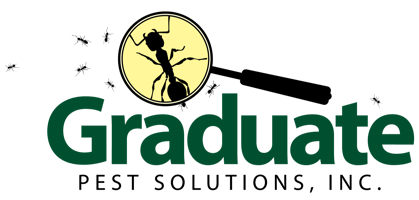Inspect
For every occassional invader treatment, our specialist will thoroughly review your home, determine the entry points, and prepare a quote for your service.
Prepare
Preparation for occasional invaders can vary from cleaning the affected area to needing the home to be vacant. We provide preparation guidance on a case-by-case basis when treating.
Treat
Our treatment procedure typically involves a system of baits and sprays. Your technician will perform service on both the internal and external parts of your home.
Identifying Occasional Invaders
"Graduate is a very good and professional company. The workers are extremely professional and knowledgeable. They can evaluate the problem and then rectify it. They can be counted on to respond very quickly and will discuss what they will do to solve the problem. I highly recommend them."
Susan D.
Occasional Invader Control
Clover Mites
Clover mites, tiny arachnids measuring about 1/30 inch long, are reddish-brown in color. They feed on plant sap and often infest clover, grass, and other vegetation, particularly in the spring and fall. Though harmless to humans and pets, their presence can be a nuisance when they invade homes in large numbers, seeking shelter from extreme temperatures. These pests typically enter buildings through small cracks and gaps in search of moisture.
Crickets
Crickets, known for their distinctive chirping, are insects belonging to the Gryllidae family. These nocturnal creatures possess robust hind legs adapted for jumping and produce their signature sounds by rubbing their wings together, primarily for communication and mating purposes. They thrive in diverse habitats worldwide, ranging from forests and grasslands to urban areas. Crickets are omnivores, feeding on organic matter such as plants, insects, and decaying material. While considered beneficial in ecosystems as scavengers and prey for various animals, they may become pests indoors, particularly in damp environments, where they seek shelter.
Earwigs
Earwigs are identifiable by their pincer-like cerci at the end of their abdomens. Despite their name, they do not typically invade human ears. These omnivorous creatures feed on a variety of organic matter including plants, insects, and decaying material. They prefer moist environments and are commonly found in gardens, mulch, and under rocks or logs. While they may occasionally enter homes, they are generally considered harmless and can be managed through preventative exterior treatments.
Firebrats
Firebrats, relatives of silverfish, are small wingless insects characterized by their flattened bodies and fast movements. They prefer warm, humid environments and are often found in places like kitchens, bathrooms, and basements. Firebrats feed on starchy materials like book bindings, cardboard, paper glues, flour, and pet foods, making them potential pests in homes and businesses. While they do not pose significant health risks, their presence can be undesirable. Controlling firebrat infestations involves reducing moisture levels and eliminating food sources.
Ground Beetles
Ground beetles vary in size, color, and habitat preferences. Ground beetles prey on a variety of pests including caterpillars, slugs, and aphids, making them valuable allies in natural pest control. Some species may occasionally enter homes but they are generally harmless to humans and can be minimized through preventative exterior treatments.
Ladybugs
Ladybugs don't typically pose health issues beyond being a nuisance. To control ladybugs indoors, seal cracks and gaps where they may enter, vacuum them up gently, and release them outdoors. Preventive measures include installing window screens and weather stripping.
Pill bugs
Pill bugs are often found in damp environments like gardens and under decaying organic matter. Recognizable by their segmented bodies and ability to roll into a ball for protection, they feed on decaying plant material and are beneficial to soil health. However, in large numbers, they can damage young plants and seedlings. To manage pill bug populations, reduce moisture levels in the garden and remove organic debris.
Millipedes
Millipedes are arthropods characterized by their long, cylindrical bodies with numerous segments, each bearing two pairs of legs. Despite their name, they typically have fewer than 100 legs. Millipedes thrive in moist environments and feed on decaying organic matter. While generally harmless to humans, they may become pests when they invade homes in search of moisture or shelter. To prevent millipede infestations, maintain dry conditions around the home, seal entry points, and remove organic debris from the surroundings.
Silverfish
Silverfish are small, wingless insects known for their silvery-gray color and wriggling movement resembling a fish. They prefer damp, dark environments and feed on carbohydrates, including paper, glue, and textiles, making them common household pests. While not harmful to humans, they can damage books, clothing, and wallpaper. Control methods include reducing humidity levels, sealing entry points, and eliminating food sources. Chemical treatments may be necessary for severe infestations, but non-toxic alternatives are preferred for indoor use.
Spider Mites
Spider mites are tiny arachnids known for their destructive impact on plants. These pests feed on plant fluids by piercing leaf cells, causing stippling, yellowing, and eventually leaf drop. They thrive in warm, dry conditions, often infesting indoor and outdoor plants. Control measures include regular inspection, pruning affected plant parts, and using natural predators like ladybugs.
Springtails
Springtails are small, wingless insects known for their ability to jump. They inhabit moist environments like soil, leaf litter, and decaying organic matter, where they feed on fungi, algae, and detritus. While harmless to humans, they may become nuisance pests when they invade homes in search of moisture. Managing moisture levels indoors and sealing entry points can help prevent springtail infestations.
Stink bugs
Stink bugs have a unique shape as well as foul-smelling defensive secretion. They feed on a variety of crops, including fruits, vegetables, and ornamental plants, causing damage through piercing-sucking mouthparts. While primarily outdoor pests, they may enter homes in search of shelter during cooler months. Preventive measures include sealing entry points and removing vegetation near structures. Chemical control methods may be necessary for severe infestations.
Box Elder Bugs
Box elder beetles, also known as boxelder bugs, are black insects with distinctive red markings. They primarily feed on box elder trees, as well as other maple species, but do not cause significant damage to healthy trees. In autumn, they may congregate in large numbers on sunny surfaces, including buildings, seeking shelter for the winter. While they do not harm humans or structures, their presence can be a nuisance. Control methods include sealing entry points and removing nearby host trees.
Fruit flies
Fruit flies are attracted to ripe or decaying fruits and vegetables. They lay eggs on these substrates, and their larvae feed on the fermenting food. Fruit flies are common household pests, particularly in kitchens and garbage areas. Prevention involves proper storage of produce, prompt disposal of overripe fruits, and maintaining clean kitchen surfaces. Traps are utilized for infestation.
Sow bugs
Sow bugs have similar segmented bodies to pillbugs. While generally harmless, they may damage young plants and seedlings in large numbers. Managing sow bug populations involves reducing moisture levels in gardens, removing organic debris, and sealing cracks to prevent their entry into structures.


